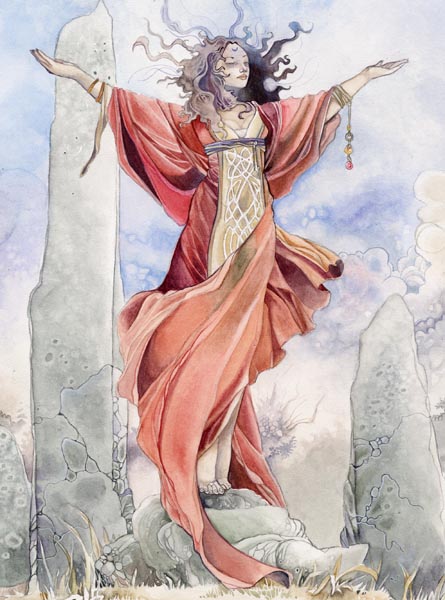
by Stephanie Pui-Mun Law
SHR Main Page | Aurelius' Sanctum
 |
by Stephanie Pui-Mun Law |
Turris Alba was founded at the suggestion of Aurelius of Bonisagus, following the chaotic events of the Stonehenge Tribunal meeting of 1221. Its other founding members were all initiated at that tribunal, and all held the conviction that something had to be done about the ugly, confrontational nature of Hermetic politics in England. In his last years of apprenticeship Aurelius had come across a strong magical aura focused upon an old Roman tower in the Forest of Torwood, and upon receiving a modest quantity of books, silver and vis from his original covenant of Glastonia, he led his fellow magi to the site. Turris Alba is still in its very earliest stages of Spring, and in 1221 its profile is as follows:
The Kingdom of England is in a period of minority rule under King Henry III, and it has seen a dramatic decline in its fortunes since the heady days of the Angevin Empire over which Henry II and Richard Coeur de Lion held sway. Before dying of dysentery, King John, father of the present King Henry, succeeded only in losing his crown (literally), the Duchy of Normandy and many of the other Angevin lands in France, and a substantial part of his royal power thanks to the barons' revolt and the Magna Carta that he was forced to sign in 1215. The situation has at least settled down somewhat, and the young king is now ably served by three magnates who act as regents: the Papal Legate Pandulf, the Justiciar Hubert de Burgh and the Vice-Chancellor Ralph Neville. The future, however, may prove to be just as turbulent as the past, and no one can say what changes will occur when Henry comes of age and into his full power.
Traditionally, the north of England has been a source of difficulty for the Norman and Angevin Kings. William the Conqueror crushed a Saxon rebellion in Yorkshire with great brutality, and the northern barons were among those who proved to be most troublesome to King John. However, York remains one of the foremost cities in England, and Archbishop Walter de Grey is a magnate of great spiritual and temporal power: in the English Church he is second only to the Archbishop of Canterbury, and he is one of the foremost landowners in the north. The archbishop hopes that his extensive rebuilding of York Minster will be remembered as one of the great achievements of the age, but the city is also remembered for less worthy reasons. In 1190 many of the Jews of the city were trapped by a mob inside its wooden castle, which was then burned to the ground. The people of York and their archbishop should not be too soon to congratulate themselves for their piety and godliness, even when the spires of the minster soar to their most glorious height...
The Forest of Torwood stands about thirty miles to the northwest of York, and immediately to the south, north and east lie the feudal holdings of the de Marnay family. The Conqueror entrusted these lands to one of his French knights, Ranulf de Marnay, after the Harrowing of the North, and his ancestor Richard now rules them as baron. Lord Richard is an austere, reclusive man who uses his tenants harshly, and the rough, inhospitable land yields poor harvests; the people do not have much to content themselves with after the baron's bailiffs have taxed them to the hilt. Three manorial villages lie within the baron's demesne: Torford to the east of the forest, Marchmoor to the north and Hernsham to the south. Of these, only Hernsham has any claim to prosperity, as a centre of trade along the road to York, although Torford is nominally the most important as it stands close to the baron's castle. There is, or was, a fourth village called West Leigh, but no one talks about that place any more without crossing themselves afterwards. The bleak Darlow Moors lie to the north of the forest, and the demesne of the Baron de Valennes can be found to the northwest. The small monastery of St. Wystan's stands on the north eastern edges of the moors, and if the rumours are true then neither the Baron de Valennes nor the abbot think a great deal of their southern neighbour.
Although their exact nature remains a mystery, the forest also seems to be the home of powerful faeries. Their champion is a mighty warrior who calls himself Erleon of the Shining Pennant, and he claims to be the servant of one called "the Lord of the Starbright Court." There are other, stranger faeries to be found in the woods, but they do not seem ill disposed towards those who treat them with caution and respect.
 |
by Stephanie Pui-Mun Law |
The Stonehenge Tribunal was founded in 817, following the agreement between Trianoma and Pralix that led to the Ordo Miscellanea joining the Order of Hermes as House Ex Miscellanea. After early battles with the remaining followers of Damhan-Allaidh, relative peace and stability were achieved, and the new tribunal attracted many magi of Houses Bjornaer, Merinita and Diedne, as the British Isles in the 9th and 10th Centuries were still isolated and uncivilised compared to mainland Europe. House Ex Miscellanea remained a powerful, organised force in spite of its diverse ways, for Pralix wanted to be prepared should Damhan-Allaidh somehow return, and House Bonisagus took advantage of the goodwill generated by Trianoma's diplomacy to establish a notable presence in the tribunal.
House Diedne also became a powerful force in the tribunal, and so England and Wales bore the brunt of much of the fighting in the time leading up to and including the Schism War. The victorious magi of Flambeau and Tremere and their allies quickly moved in to occupy the covenants of their slain Diedne enemies, and it is from this era that the Briton-Latin divide originates, as the newcomers tended to view the native English magi as potential Diedne sympathizers and treated them accordingly. However, over the next several decades the Latins' power was eroded as their most powerful leaders successively fell victim to a series of seemingly unconnected Wizards' Wars, laboratory accidents, gruesome deaths at the hands, claws or teeth of monsters whilst gathering vis, and Wizards' Marches declared on the basis of less-than-wholly substantiated charges. At the same time the Latin covenants were driven apart by an unprecedented degree of discord and bickering, and they hardly noticed as Caeranwn gathered more votes with every passing tribunal meeting.
In the late 12th Century the Prima Immanola of House Ex Miscellanea prophesied that an impending crisis would destroy the Order of Hermes, and speculation was rife that she would call upon her house to secede and re-establish the Ordo Miscellanea. Thus far the crisis has not materialized, and Immanola's reputation has suffered somewhat, but among some British magi the idea of breaking away from the Order is undoubtedly popular. The behaviour of the Latins after the Schism War generated a lot of resentment, and Caeranwn was able to capitalise on this by presenting itself as the guardian of the rights, privacy and unique traditions of British wizards. This earned the covenant a lot of legitimate support, and it now dominates the Stonehenge Tribunal completely.
There are nine covenants in the tribunal, in which most of the magi live. The tribunal is noted, however, for its high number of eremites, or magi who live on their own and generally stay out of the business of their sodales. In recent years, as mundane society has encroached further upon magical lands and as the tribunal has become increasingly polarized, more of these eremites have sought the protection of covenants, but the powers and intentions of those who remain solitary are keenly speculated on by other magi.
There are many legends, secrets and rumours that have become favourite topics of debate and discussion for English magi whenever they meet. Some magi dismiss many of these as hearsay and nonsense but others actively seek out the truth behind them, believing that they will gain great power when they find the answers that they are looking for.
Perhaps not surprisingly, the oldest and most widespread of the tales pertain to Arthur, Merlin and the Holy Grail. No one pays much heed to the suggestion that Arthur will return one day, although there is a small coven of Ex Miscellanea Witches, known as the Doomsayers of Camlann, who regularly meet in the Somerset marshes where they claim he was taken to the Isle of Avalon. More attention is paid to the legend that states that Merlin was the son of a demon, and some among the Seekers believe that his father was actually an Old One in the form of a dragon. They call this dragon the Lloigor, and they imagine its lair to be somewhere in the mountains of Wales. These magi keenly wonder what would happen if the dragon were to emerge and father another mortal child, or if Merlin himself were to be found and roused from his magical slumber. Many more magi are interested in the Holy Grail and remember that St Joseph of Arimethea is said to have brought it with him to Glastonbury from the Holy Land. Quite a number of magi over the years have devoted much of their careers to scouring the holy and mystical sites of Britain in search of the Grail, and the competition to find it is sometimes very intense. In fact, the opposing factions of the tribunal are taking more and more interest in these tales as their rivalries heat up - the prospect of discovering the secret that would give them ultimate power over their enemies is very attractive.
Neither is the Order in England short of a few legends of its own. Damhan-Allaidh is generally believed to be long dead, but no one is entirely sure about his allies and followers, and an ultra-secret group known as the Praeses Septentrionalis is said to exist in order to hunt them down and destroy them (it probably takes its inspiration from the group of covenants of the same name, founded to watch for signs of Damhan-Allaidh's return). The Schism War is not forgotten either, for House Diedne was strong in the British Isles and the last battles were fought in England. Perhaps, if it is true that the Primus Llewellyn and his followers will return, the fighting is not yet over. Rumours persist of other druidic magi who fled into hiding, and even of House Diedne covenants that somehow shielded themselves from the onslaught of the Tremere and secretly stand to this day, filled with terrors that will one day be unleashed upon the Order. Some magi shudder at the prospect of such tales actually being true, but others are eager to know more, keen as they are to find challenges worthy of them, to best terrible foes and master secret magics that might make them equal to the Founders themselves.
Text copyright © Simon Foston 2007.
Details from Morgan le Fey copyright © Stephanie Pui-Mun Law 2007.